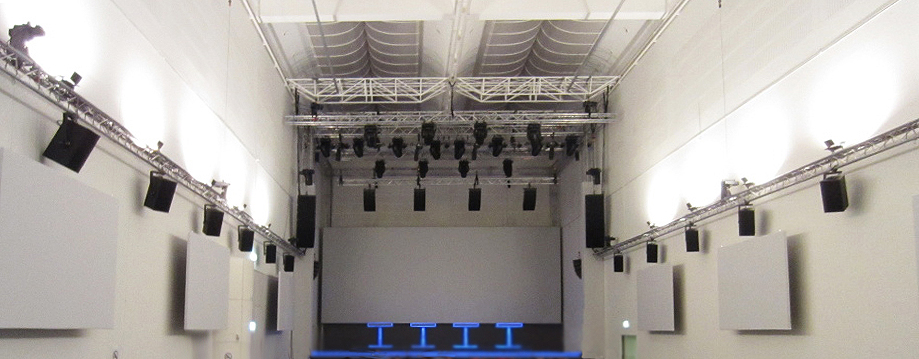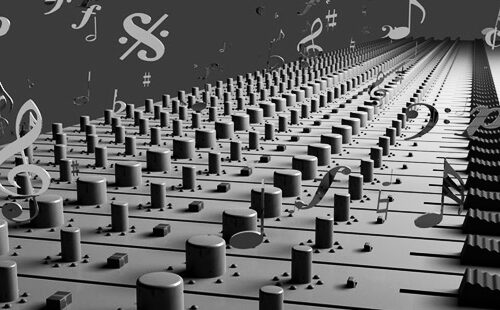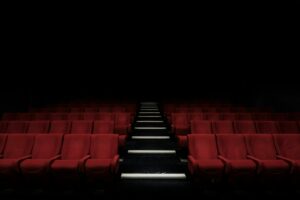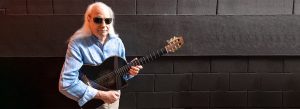
The band Kraftwerk has always stood for innovation. With their albums Autobahn, Trans Europa Express, Die Mensch-Maschine and Computerwelt revolutionized the music world and laid the foundation for modern electronic music. At the end of January 2018, Kraftwerk won the Grammy in the "Best Dance/Electro Album" category with the live album 3-D Der Katalog, which was the first Kraftwerk album to be released in Dolby Atmos. We talked to Fritz Hilpert about the production of this record and what Dolby Atmos means for electronic music in general.
You were also nominated in the category “Best Surround Sound Album” at the Grammies as 3D Surround Mix Engineer, while 3-D Der Katalog was the first Kraftwerk album ever to be mixed in three-dimensional Dolby Atmos. Is this sound made for the man-machine Kraftwerk as pioneers of electronic music?
Of course, electronic music is very suitable to be reproduced on a multichannel speaker system like Dolby Atmos, as a projection of individual sounds onto a virtual sound dome. Although these systems were primarily developed to create the illusion of a concert hall, or to represent a film scene acoustically analog, they offer a whole new creative level for the electronic producer.
Already in the fifties, experiments with differently arranged loudspeakers were carried out in the “Studio für Elektronische Musik” in Cologne.
“These systems offer a whole new level of creativity for electronics producers”

What was the process of mixing Kraftwerk immersively for the first time? Did you have any previous experience?
We had previously mixed the live album Minimum Maximum in 5.1, which was released as a DVD and SA-CD.
The principle of reproducing a live concert was still followed. Room microphones were used to record the acoustics of the hall and the reactions of the audience and incorporated into the surround mix. We have always tried to install at least one Quadro system at the concerts as well.
Today’s Soundscape system (d&b audiotechnik), with an unlimited number of channels, as it were, offers all the possibilities of multidirectional sound reinforcement.
“The 3rd dimension, i.e. the introduction of the height speakers, plays an essential role here, as if a third emotional level were also introduced here.”
Most people know Dolby Atmos from the cinema. In music, most Dolby Atmos productions come from the classical and jazz genres, although electronic music should be particularly grateful for the new possibilities offered by Dolby Atmos?
Immersive Audio was still pretty fresh in 2016, when it started production, and is still struggling to gain traction in the music market today. Phenomena like the vinyl revival don’t make it any easier.
However, the home cinema sector and the fact that many films are produced in Dolby Atmos are of help. The growing number of Atmos soundbars already brings the technology into the house, which you can then also use to listen to immersive music.
In the production of 3-D Der Katalog, the recreation of the concert hall and any ambience were omitted entirely. Once you detach yourself from the pretense of depicting a real situation, a whole new horizon opens up that adds real value to the listening experience of music.
The 3rd dimension, i.e. the introduction of the height speakers, plays an essential role here, as if a third emotional level were also introduced here.
Thus, this Blu-ray should be considered a studio-only album, but using original and live tracks to preserve both the magic of the live performance and the highest sound quality.

“Voices get a special closeness when they are pulled a bit into the room and thus reproduced proportionally by several loudspeakers.”

Can all the new possibilities and ways to manipulate sound and the freedom to position it anywhere in the room also overwhelm?
Is there a danger of sensationalism?
It is true that many possibilities want to be used on the one hand, but on the other hand they can quickly turn out to be pointless gimmicks. Therefore, the music must first be transformed in the imagination into a graphic three-dimensional construct.
Usually, high frequency ranges are also located in the altitude while heavy basses remain in the base or even slip into the LFE channel (subwoofer). Synthetic sounds in the form of sound surfaces are separated or juxtaposed in the surround area to create an envelopment. This is often done with the support of reverb or delay effects.
Voices get a special closeness when they are pulled a bit into the room and thus reproduced proportionally by several loudspeakers. Additive voices may also sometimes come from a distant corner or from above.
Courage to be imaginative is definitely called for. However, this only applies to a limited extent when it comes to movements. A very deliberate approach must be taken here. That means you should already have a plan of what moves where and why.
Even very subtle slow movements of a sound towards the listener can be interesting, which works very well especially in binaural playback.
3-D DER KATALOG the 3D concert film naturally calls for the analog acoustic movements in “Autobahn” or “Trans Europa Express”. Even a wild space flight like in “Spacelab” is allowed then and finally confirms the listener in his decision to have installed an Atmos system.
As in reality, the 3D film makes its way to the eye at most, and the sound continues to the back. But there is also a lot of room for precisely this creative positioning freedom in the abstract.
You are also responsible for the Dolby Atmos mix of Booka Shade’s new album Dear Future Self. Just like 3-D Der Katalog, this album can be located in the field of electronic music. Where are the similarities in the production process and what are the differences?
Since both are purely electronic music, the similarities are obvious. However, the correlation to the picture doesn’t matter with the Booka Shade album, as it’s a Pure Audio Blu-ray, as it was with the 2018 album Galvany Street. There are also three audio tracks here in stereo, Atmos and binaural.
While 3-D Der Katalog offers many musical facets, Dear Future Self is a clearly dancefloor-oriented work, peppered with very beautiful electropop songs, such as “Polar Lights” or “I GO, I GO”.
Nevertheless, there is a visual model for the design of the mixture. Due to the consistent distribution of rhythm elements and keyboards in all directions, one feels enveloped by the sound; like on a dance floor around which several DJs are “battling”. To this end, vocalists enter the room like acoustic holograms.
Dear Future Self is thus a bold approach away from mono maximum pressure to a dynamic transparent club sound. I wish I could actually experience music like that in a club.





